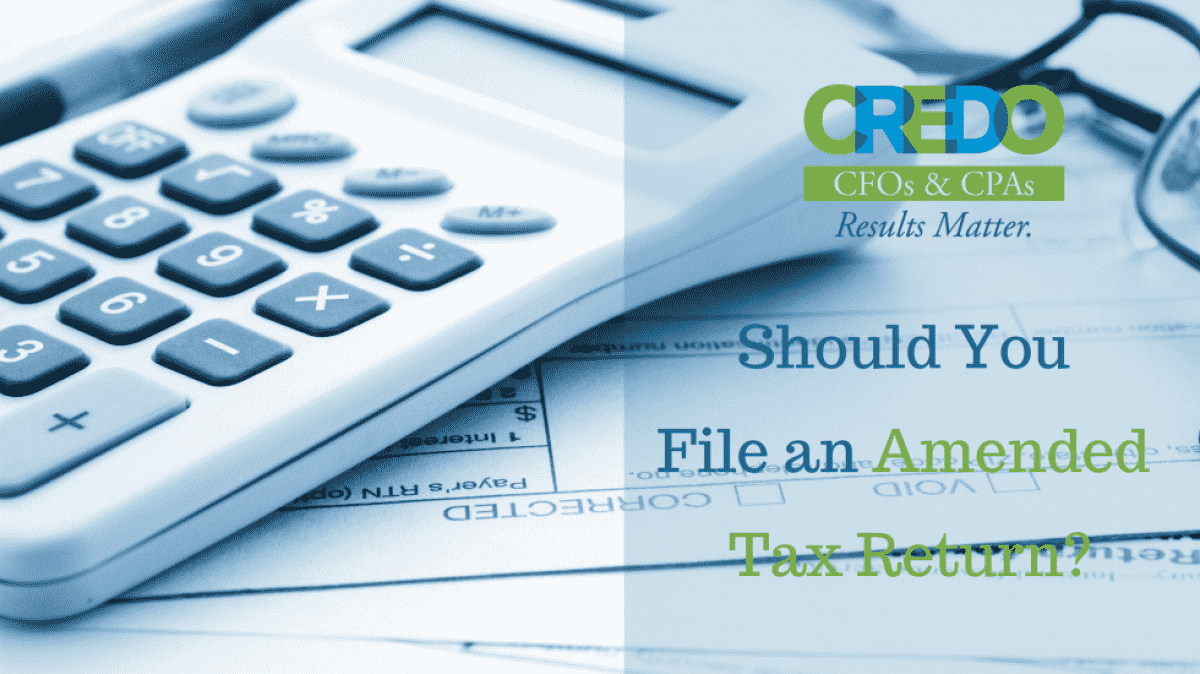Should You File An Amended Tax Return?

The Internal Revenue Service (IRS) makes it easy to file an amended tax return.
Have you realized you made a mistake on your tax return or failed to claim a deduction or credit you were entitled to?
To rectify this, simply submit an amended tax return. The Internal Revenue Service (IRS) makes it easy to file an amended tax return.
Justifications for Filing an Amended Return
- To make sure your financial records are accurate
File an amended return if you realize you forgot to include income (from a Form W-2 or 1099, for example) or if you received a revised information statement that reflects a change in your income or withholding amounts.
That holds true whether you expect a bigger tax refund or anticipate having to pay more. A CP2000 notification from the IRS is likely if you’ll have a larger tax bill and don’t file an amended return.
- To change your filing status
If the conditions are right, you can switch to a more advantageous filing status.
The standard deduction would be reduced by $3,000 if you claimed single status when you were actually eligible for the more generous head-of-household filing status. Changing your filing status is not always possible (it depends on your circumstances), but it is a valid cause to file an updated return.
- To adjust your deductions
You need to file an updated return if you made a mistake on your original return, such as failing to properly itemize your deductions or including or excluding a dependant. This may help avoid complications down the road like notices or an audit by the IRS.
- To make a credit claim or a credit correction.
Credits are frequently linked to dependents on your tax return. Even if you have the correct dependents, you may have claimed a credit that you should not have. Correct the error by revising your return. This will ensure that you receive your maximum refund without obtaining a tax bill after the fact.
If you file your taxes and then notice a mathematical or clerical error, you likely won’t have to file an amended return. In most cases, the IRS will automatically fix these kinds of mistakes and give you a bill for the additional tax owed or a refund if the mistake was in your favor.
Verify that the IRS has already processed the original return before filing an amendment. As a result, the Internal Revenue Service is less likely to confuse your initial return with your updated return. You will know that the IRS has completed your return if you have received your refund.
The IRS has strict time constraints for filing an updated return to get a refund, so keep that in mind.
Within two years of making the payment that is equal to or greater than the amount of tax that is owed for that year; otherwise, within three years of the original filing deadline. Within that time frame, you can change your return and still get your money back.
How to File an Amended Tax Return
Filing a tax return with corrections is a simple process. The procedure is outlined below.
- Assemble the necessary paperwork. Gather your current tax return and any additional paperwork you may need to file an amendment. A new or revised W-2 or 1099 form may be available if you need to revise the amount of income you reported on your tax return. If you failed to claim a tax deduction or credit and are now trying to do so, you will need to provide proof in the form of a receipt for a charitable contribution, a new or revised Form 1098 Mortgage Interest Statement, or a Form 1098-T for an education credit.
Tax Tip: Include any new or revised documentation to back up your claims when filing an updated return, such as a new W-2 or 1099 to report increased income, a new or revised Form 1098 Mortgage Interest Statement, or a new or revised Form 1098-T to claim an education credit.
- Obtain the appropriate paperwork. Form 1040-X is the appropriate IRS form to file if you need to make changes to your tax return. Similarly, you’ll need any updated forms that require them. You will also require a copy of Schedule A for the relevant tax year, for instance, if you wish to modify your itemized deductions. You will probably require a copy of Schedule B if you need to file an amended tax return to include additional interest or dividend income. Schedule C and Schedule SE are often required when there are adjustments to business income or costs. Form 8949 and Schedule D, etc., may be required if you have any changes to your capital gain or loss amounts.
- Prepare a 1040-X tax return. There are three columns on Form 1040-X:
Column A: You can see the figures from your prior tax return in this column. Fill out this section using the copy of your tax return you obtained in Step 1.
Column B: In this column, you’ll see the percentage increase or decrease that should be made to the amounts from your original return. To add $50 in interest income that was overlooked on your original tax return, you would enter that amount on line 1, column B of your amended gross income.
Column C: Here you can see the accurate sum displayed in this column. To fill this out, simply sum up the figures in columns A and B.
Justify your need to file an amended return in Part III of Form 1040-X.
- Submit your amended forms. If you filed your original return online and your tax software provider enables filing amended returns electronically, you can e-file your tax returns with the IRS starting with the 2019 tax year. You’ll need to print the completed Form 1040-X and any other forms you’re updating in order to change a return for 2018 or earlier. Include any required supporting documents, such as:
- Any updated or new W-2s and 1099 forms
- Schedule A, for example, if you altered your itemized deductions, is another form or schedule that changed.
- Any letters you got from the IRS about your updated return
Send all the paperwork to the address listed in the instructions, or if you can, file the return electronically.
You will be required to pay more taxes if changing your tax return increases your tax liability. After logging into the IRS system, you may either go online and make a payment at their website or submit a check along with the revision. You can reduce the interest and penalties you’ll have to pay by paying immediately rather than waiting for the IRS to issue you an invoice.
Remember that the IRS may require up to eight weeks to process an amended tax return if you file it on paper as opposed to electronically. Using the IRS’ Where’s My Amended Return tool, you may determine the status of your amended return. After mailing your return, allow three weeks for the information to appear in the IRS system.
You’ll probably need to file an amended tax return with your state if you amend your federal income tax return. A tax return amendment form is specific to each state. You might want to change your withholding if your amended forms reveal that you owed a sizable amount in taxes or received a sizable refund.
When Not to File an Amended Return
The IRS can get into a lot of trouble if you make this common error.
People often file an updated return when they really shouldn’t, including in the following cases:
- They were issued a CP2000 warning.
- There was a math error that needs to be fixed.
- However, the IRS did not accept their electronically submitted tax return.
- They failed to include their W-2 with the tax return.
Get in touch with Credo if you have more questions about filing an amended return. With Credo, you have the assurance that your taxes, no matter how straightforward or intricate the returns may be, are being handled correctly.



